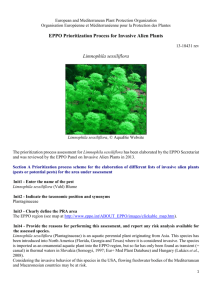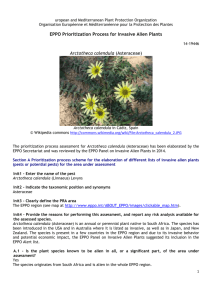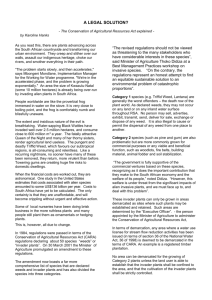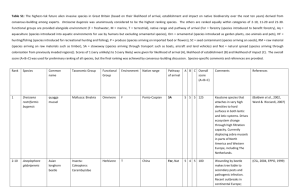priorization
advertisement
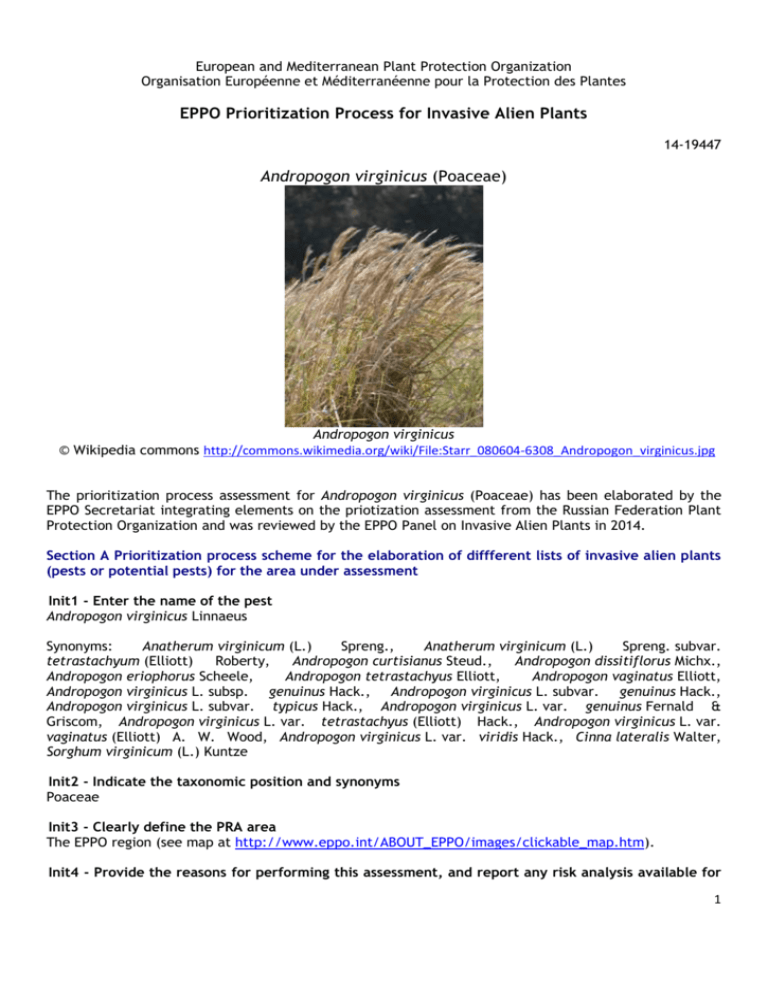
European and Mediterranean Plant Protection Organization Organisation Européenne et Méditerranéenne pour la Protection des Plantes EPPO Prioritization Process for Invasive Alien Plants 14-19447 Andropogon virginicus (Poaceae) Andropogon virginicus © Wikipedia commons http://commons.wikimedia.org/wiki/File:Starr_080604-6308_Andropogon_virginicus.jpg The prioritization process assessment for Andropogon virginicus (Poaceae) has been elaborated by the EPPO Secretariat integrating elements on the priotization assessment from the Russian Federation Plant Protection Organization and was reviewed by the EPPO Panel on Invasive Alien Plants in 2014. Section A Prioritization process scheme for the elaboration of diffferent lists of invasive alien plants (pests or potential pests) for the area under assessment Init1 - Enter the name of the pest Andropogon virginicus Linnaeus Synonyms: Anatherum virginicum (L.) Spreng., Anatherum virginicum (L.) Spreng. subvar. tetrastachyum (Elliott) Roberty, Andropogon curtisianus Steud., Andropogon dissitiflorus Michx., Andropogon eriophorus Scheele, Andropogon tetrastachyus Elliott, Andropogon vaginatus Elliott, Andropogon virginicus L. subsp. genuinus Hack., Andropogon virginicus L. subvar. genuinus Hack., Andropogon virginicus L. subvar. typicus Hack., Andropogon virginicus L. var. genuinus Fernald & Griscom, Andropogon virginicus L. var. tetrastachyus (Elliott) Hack., Andropogon virginicus L. var. vaginatus (Elliott) A. W. Wood, Andropogon virginicus L. var. viridis Hack., Cinna lateralis Walter, Sorghum virginicum (L.) Kuntze Init2 - Indicate the taxonomic position and synonyms Poaceae Init3 - Clearly define the PRA area The EPPO region (see map at http://www.eppo.int/ABOUT_EPPO/images/clickable_map.htm). Init4 - Provide the reasons for performing this assessment, and report any risk analysis available for 1 the assessed species. Andropogon virginicus (Poaceae) is a perennial grass native to North and Central America. This species has been introduced and naturalized in Australia, New Zealand and Japan. Prior to 2006, the only report from the EPPO region was in Georgia and the Russian Federation. In 2006, it was first found in France in a military camp. Because the population of A. virginicus has multiplied significantly in the infested area in France (from 2 to 500 plants in two years) and the species is considered to be invasive in other parts of the world, the French Plant Protection Organization (PPO) suggested adding A. virginicus to the EPPO Alert List. The Russian Federation PPO also performed a prioritization report assessment on A. virginicus which concluded that this species has a high spread potential and high potential environmental impact. A.1 - Is the plant species known to be alien in all, or a significant part, of the area under assessment? Yes The species originates from North and Central America and is alien in the whole EPPO region. A.2 - Is the plant species established in at least a part of the area under assessment? Yes (for references and an updated distribution, please, check the EPPO PQR Database https://www.eppo.int/DATABASES/pqr/pqr.htm) The species is established in the EPPO region: France, Georgia and the Russian Federation. In France, the species was found in 2006 in the military camp ‘Camp du Poteau’ (Landes and Gironde departments) and has also been recorded in Arjuzanx (Landes). In the Russian Federation, the species is established on the Black Sea coast of the Caucasus. A.virginicus was first recorded in 1947 in Georgia in the Autonomous Republic of Abkhazia near the Lake Bebsyr (Ochamchira (Очамчыра) region). The pathway of entry is not known. In the Autonomous Republic of Abkhazia, the species is widespread in the natural environment as well as in ruderal and disturbed land across the low-lying (up to 250 m) maritime part of the country (Колаковский, 1986) and is expanding its range in the Caucasus region. The most northern point of its spread is the region of Tuapse town (Туапсе) where in 1996 the population of this species was dominant in the area of a former vineyard on the marine terrace of the bank of the estuary (Зернов и др., 2000). Map of occurrence of A. virginicus in the Black Sea coast of the Caucasus (yellow dots – the Russian Federation, pink dots – Autonomous Republic of Abkhazia, green dots – Georgia) The species is native to North America: Canada (Ontario), Mexico, USA (Alabama, Arkansas, California (alien), Connecticut, Delaware, District of Columbia, Florida, Georgia, Hawai (alien in West Maui), Illinois, Indiana, Iowa, Kansas, Kentucky, Louisiana, Maryland, Massachusetts, Michigan, Mississippi, Missouri, New Jersey, New York, North Carolina, Ohio, Oklahoma, Pennsylvania, Rhode Island, South Carolina, Tennessee, Texas, Virginia, West Virginia). It is also native to Central America: Bahamas, Belize, Bermuda, Colombia, Costa Rica, Cuba, Dominican Republic, Guatemala, Honduras, Jamaica, Nicaragua, Panama, Puerto Rico, Trinidad and Tobago. 2 The species has also been introduced and is established in Australia (New South Wales, Queensland, Victoria), in Japan and in New Zealand. World distribution maps are displayed in figure 1 and 2. Figure 1: EPPO Worlwide distribution map for Andropogon virginicus. Figure 2: GBIF worldwide distribution for Andropogon virginicus. Records are missing in the EPPO region (France, Georgia and in the Russian Federation). Biodiversity occurrence data accessed through GBIF Data Portal, data.gbif.org, 2014-04-03. The GBIF Niche Model, taking all the available parameters into account, indicates that the Atlantic and temperate and Mediterranean European areas would be suitable for A. virginicus to establish (Figure 3). This projection fits well with the distribution of the species, but underestimates its distribution in Central America. The potential distribution of the species could then be underestimated. The temperate area is considered to be most suitable for A. virginicus, as well as the Atlantic area. 3 Figure 3: Worldwide Projection of the GBIF Niche Model of Andropogon virginicus. Biodiversity occurrence data accessed through GBIF Data Portal, data.gbif.org, 2014-03-26. Questions A.5, A.6, A.7 and A.8 all have to be assessed independently. The risk should be considered for the area under assessment where the species is able to establish and to cause damage. The risk should not be downgraded by making an average for the entire area under assessment, if it is different from the area of potential establishment. As far as possible, evidence should be obtained from records of invasive behaviour in the area under assessment or in the EPPO region. Information on invasive behaviour elsewhere may also provide guidance. It should be ensured that suitable habitats are present in the area under assessment, for instance, mangroves and some specific cropping systems are not found in the EPPO region. Any impact through hybridization on native plant species, crops or wild crop relatives is also considered in this section. A.5 - How high is the spread potential of the plant in the area under assessment? High Level of uncertainty: Low Production of propagules by A. virginus is high. Each flowering culm may have as many as 50 racemes, and each raceme 8 to 12 spikelets. Survival of seedlings is high (Uchytil, 1992). The fine achenes of the species are spread naturally by wind, by floating on water and can also adhere and be transported by waterfowl, on wool, fur or on people’s clothes. The species is also likely to be spread by machinery (Pacific Island Ecosystems at Risk Website). Concerning its natural spread potential, in 2 years the population of A. virginicus found in France increased from 2 plants to more than 500 (Granereau & Verloove, 2010). A.6 - How high is the potential negative impact of the plant on native species, habitats and ecosystems in the area under assessment? List natural and semi-natural habitats where the species in known to occur. It includes all EUNIS habitat types 1 (http://eunis.eea.europa.eu/habitats-code-browser.jsp), except I (Regularly or recently cultivated agricultural, horticultural and domestic habitats) and J (Constructed, industrial and other artificial habitats). Medium 4 Level of uncertainty: High According to the EUNIS nomenclature, the following natural or semi-natural habitats are invaded: Inland water surface: Littoral zone of inland surface waterbodies [C3]; Mires, bogs and fens: Raised and blanket bogs [D1]; Grasslands and lands dominated by forbs, mosses or lichens: Dry grasslands [E1], Messic grasslands [E2]; Seasonally wet and wet grasslands [E3]; Woodland fringes and clearings and tall forb stands [E5]; Sparsely wooded grasslands [E7]; Woodland, forest and other wooded land: Broadleaved deciduous woodland [G1]; Broadleaved evergreen woodland [G2]; Coniferous woodland [G3]; Mixed deciduous and coniferous woodland [G4]; Lines of trees, small anthropogenic woodlands, recently felled woodland, early-stage woodland and coppice [G5]. A. virginicus forms monospecific stands and releases highly persistent allelopathic substances (Rice, 1972), displacing other species. These substances are also released by decaying material which have been observed in the USA to inhibit the growth of Amaranthus palmeri (Aamaranthaceae), Bromus japonicus (Poaceae) or Schizachyrium scoparium (Poaceae) (Uchytil, 1992). A. virginicus dead material is an excellent fuel for fires. In areas where it occurs, both fire intensities and acreage burnt have increased, which may change the structure and composition of the ecosystems (Smith, 1998). The species cover also increases with burns (Smith, 1998). It is dormant during the rainy season, which leads to increased erosion in some areas (Mueller-Dombois, 1973 in Smith, 1998). SEREP (2000) also notes that, as the species has a tendency to form dense mats of dead matter, it results in increasing runoff and accelerated erosion. The species is reported to be able to form continuous cover in abandoned agricultural land after 4 to 5 years. But once established, it depends upon periodic disturbance to maintain its abundance (Uchytil, 1992). As little information is available on the ability of the species to form continuous cover over the years, the uncertainty is assessed as high. A.7 - How high is the potential negative impact of the plant on agriculture, horticulture or forestry in the area under assessment? The habitats and the situations in which the species has negative impact on agriculture, horticulture or forestry should be listed. It includes EUNIS habitat (http://eunis.eea.europa.eu/habitats-code-browser.jsp) I (Regularly or recently cultivated agricultural, horticultural and domestic habitats) and J (Constructed, industrial and other artificial habitats). Low Level of uncertainty: Medium According to the EUNIS nomenclature, the following habitats are invaded: Regularly or recently cultivated agricultural, horticultural and domestic habitats: Cultivated areas of gardens and parks [I2]; Constructed, industrial and other artificial habitats: Extractive industrial site [J3], Transport networks and other constructed hard-surfaced areas [J4], Highly artificial man-made waters and associated structures [J5], Waste deposit [J6]. A. virginicus is considered unpalatable and of low forage value (Uchytil, 1992). However as the species is mainly reported to invade poorly managed and/or marginal areas of pastures, the pastoral impact is thought to be minor. In forestry, control or suppression of this species may be necessary to enable the establishment of the plantation species (Groninger et al., 2004). A.8 - How high are the potential additional impacts (e.g. on animal and human health, on infrastructures, on recreational activities, other trade related impacts such as market losses)? Low Level of uncertainty: Medium 5 As seeds can catch in wool, they may be recognised as minor contaminants (Parsons & Cuthbertson, 2001 in Victorian Department of Primary Industries, Undated). The species provides grazing in summer and spring, but palatability quickly decreases as the summer progresses (USDA NRCS, 2009). Dried material remains over summer and represents a potential fire hazard (Parsons & Cuthbertson, 2001). The species has the potential to moderately increase the fuel load and the fire intensity (Victorian Department of Primary Industries, Undated). Responses to questions on impacts (A.6, A.7 and A.8) should be reported in the matrix in Fig. 2 in order to categorize the species. The highest score should be considered; however, impacts listed in question A.8 cannot be taken on their own as the highest impacts. Only if A.6 and/or A.7 is medium and A.8 is high should the overall impact be considered high. Those species that have both a high spread potential and a high impact (either on cultivated or uncultivated ecosystems) are included in the list of invasive alien plants. Species with either medium spread or impacts are included in the observation list of invasive alien plants. Species with low spread and high impact are included in the observation list of invasive alien plants. All other species are registered on the list of minor concern. The conclusions of the process can be presented in a matrix (see Fig. 2). A5 -Spread potential Low Medium High Adverse impacts Low List of minor concern List of minor concern List of minor concern (maximum rating Medium List of minor concern Observation list of Observation list of from questions invasive alien plants invasive alien plants A6, A7. and A.8) High Observation list of Observation list of List of invasive alien invasive alien plants invasive alien plants plants Fig. 2 matrix combining spread potential and adverse impacts. The answer High The answer Medium The answer Low The answer Low provided to question A.5 on the spread potential of the species assessed was: provided to question A.6 on negative impact on native species, habitats and ecosystems was: provided to question A.7 on negative impact on agriculture, horticulture or forestry was: provided to question A.8 on additional impacts was: According to the ratings provided, the assessed species falls into the: Observation list of invasive alien plants A.9 - The overall uncertainty for Part A of the EPPO prioritization process for invasive alien plants should be summarized: High The species is only at its initial stage of invasion in the EPPO region and little data is available. Where the species has been introduced (Australia, New Zealand, Japan), there is little information on the impacts of the species. The uncertainty is therefore considered as high. References Global Invasive Species Database, Andropogon virginicus. http://www.issg.org/database/species/ecology.asp?si=200&fr=1&sts=&lang=EN NOBANIS Database http://www.nobanis.org/ 6 Granereau G, Verloove F (2010) Une poacée invasive nouvelle pour la France: Andropogon virginicus (Andropogoneae, Poaceae). Bulletin de la Société Linnéenne de Bordeaux145, 417-421. Groninger JW, Baer SG, Babassana DA & Allen DH (2004) Planted green ash (Fraxinus pennsylvanica Marsh.) and herbaceous vegetation responses to competition control during the first three years of afforestation. Forest Ecology and Management 189, 161-170. Mueller-Dombois D (1973) A non-adapted vegetation interferes with water removal in a tropical rain forest area in Hawaii. Tropical Ecology 14, 1-18. NPPO of France (2011-11). Pacific Island Ecosystems at Risk Website (PIER), Andropogon virginicus. http://www.hear.org/pier/species/andropogon_virginicus.htm Parsons WT & Cuthbertson EG (2001) Noxious weeds of Australia, 2nd ed., CSIRO Publishing, Collingwood. Rice EL (1972) Allelopathic effects of Andropogon virginicus and its persistence in old fields. American Journal of Botany 59(7), 752–755 SREP (2000) Invasive species in the Pacific : a technical review and draft regional strategy. Technically edited by Greg Sherley. - Apia, Samoa. 190 pp. Smith CW (1998) Hawaiian Alien Plant Studies. http://www.botany.hawaii.edu/faculty/cw_smith/aliens.htm Uchytil RJ (1992) Andropogon virginicus. In: Fire Effects Information System. U.S. Department of Agriculture, Forest Service, Rocky Mountain Research Station, Fire Sciences Laboratory (Producer). http://www.fs.fed.us/database/feis/plants/graminoid/andvir/all.html USDA NRCS (2009) Plant fact sheet. Broomsedge bluestem, Andropogon virginicus L. http://plants.usda.gov/factsheet/pdf/fs_anvi2.pdf Victorian Department of Primary Industries (Undated) Invasiveness Assessment – Whiskey grass (Andropogon virginicus) in Victoria. Impact Assessment - Whiskey grass (Andropogon virginicus) in Victoria http://vro.depi.vic.gov.au/dpi/vro/vrosite.nsf/pages/impact_whiskey_grass Зернов АС, Костылева НВ, Мавродиев ЕВ, Сухороков АП (2000) Флористические исследования в Ростовской обл., Краснодарском Ставропольском краях. Бюллетень МОИП, отд. биол. 105(2), 53-54. http://herba.msu.ru/russian/journals/bmsn Колаковский АА, Флора Абхазии. 2-ое изд., Тбилиси (1986) т. 4, стр. 364. Плантариум (Plantarium), Бородач виргинский Andropogon virginicus. www.plantarium.ru 7
